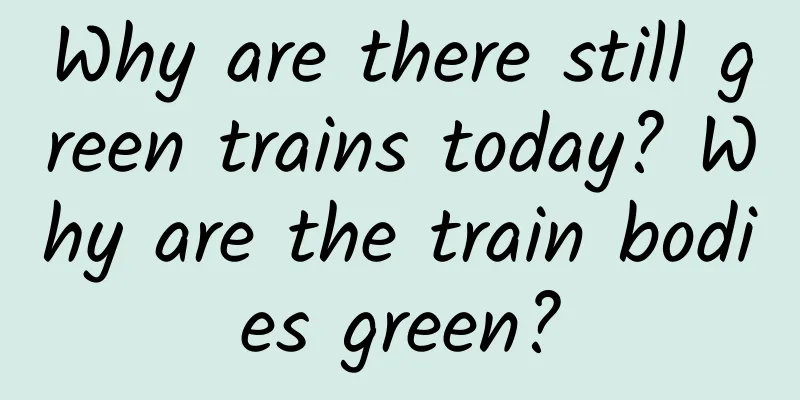Why are there still green trains today? Why are the train bodies green?

|
This article is about 6230 words Reading time: 17 min The pace of modern society is getting faster and faster. For example, when traveling, people are increasingly inclined to choose high-speed trains and airplanes, which take less time and have better facilities, rather than slow "green trains" - in fact, since the 1990s, with the continuous acceleration of China's railway transportation, the elimination and transformation of old green trains has also been increasing. But why can we still see them running across China today? In response to this question, the official Weibo account of the People's Daily released a video to popularize the importance of green trains: It turns out that the "backward" green trains still have a considerable market. Due to low construction requirements, green trains can cover places that high-speed trains cannot reach for the time being; the maintenance and operating costs of this type of train are not high, so the ticket price is much cheaper than that of high-speed trains... In remote mountainous areas, secluded small towns, and scattered villages, there are countless families who rely on these green trains to "go out." Popular science video about green trains. Source/Weibo @People's Daily "Although we now have high-speed trains that can travel at a speed of 350 kilometers per hour, we cannot do without green-skinned trains that stop at every station and offer low ticket prices." If high-speed rail represents China's speed, then green-skinned trains represent China's temperature. Whether in the past or now, their existence has extraordinary significance. Green train. Source/Weibo @People's Daily Video However, today's green trains are no longer the same as before, and their performance and ride comfort have changed a lot. Having said that, I will take you through the past and present of the "green trains". Not all trains are green They are all called "green trains" In the eyes of green train fans, only the old green train is the real "green train". The so-called old green train is the most representative image of Chinese passenger trains from the 1950s to the 1980s, and was once synonymous with Chinese railway transportation. Judging from the name, a green-skinned train is a train with a green body. However, most people born in the 1960s and 1980s had their first impression of green-skinned trains from China's second-generation main railway trains, namely the Type 22 passenger car, which also includes the improved versions of the Type 22B and Type 23 passenger cars. In 1956, the design and trial production of the Type 22 passenger car began, and it was put into production in 1959 and stopped in 1994. Among them, 22 refers to the length of the train body, that is, the total length of the Type 22 series of cars is about 22 meters. The speed of the Type 22 passenger car is between 100km/h and 120km/h, but because of the large differences in the degree of railway construction and terrain, the actual average speed is less than 40km/h, so the ticket price is very cheap; their window design adopts a double-sash single-layer glass upward opening style, and the sound insulation and sealing effect are relatively poor, which is also a big difference compared with today's trains; and except for some sleeper cars, most Type 22 passenger cars do not have air conditioning, relying on boiler heating in winter and small fans for cooling in summer. As the main model at that time, the "green train" has become the collective memory of several generations because of its grass green background and yellow ribbon. In the eyes of many people, these old-fashioned passenger cars with cheap tickets, slow speed, no air conditioning and windows that can be opened can be called green trains. Such a green train is actually not very comfortable to sit in: the slow speed makes the journey even longer, and the back and waist ache from sitting on the hard seats. If you catch the Spring Festival travel rush, there may be no place to stretch your hands and feet. There is no air-conditioning, and the carriage is like a "refrigerator" in winter. The thin iron shell not only does not keep warm but is also drafty. In summer, it is upgraded to a "sauna", and the stuffy air seems to be twisting and steaming all the time. Because the ticket price is cheap and there are no restrictions on boarding, there are all kinds of people on the train - there may even be animals. It is like a mobile market, emitting all kinds of smells, and it is so noisy that you can't expect a moment of peace. If you are used to the comfort and quietness of other modes of transportation, you probably won’t want to take a green train; or in other words, you won’t want to take it a second time. But it is precisely this simplicity and roughness that makes the “green train” a cultural symbol of an era. For a long time after the founding of the People's Republic of China, trains were almost the only means of long-distance travel for Chinese people. In the context of the time, it represented the hope and power of the industrial age: the truck driver who leaned out to look into the distance became the embodiment of the pioneer, the boiler operator who sweated profusely became a common image of a model worker, and many heroes in film and television works were often railway workers. It also became the dream ark for many young people to rush to a new world: among them, a young man from Northeast China named Zhou Yunpeng, who had been blind for many years, took a train alone to embark on the first journey of his life. He listened to the rumble of the steel wheels hitting the rails, drank a few sips of draft beer, and felt that "the world has become my buddy"; a young man with the pen name "Haizi" took a train through Delingha to follow a female writer who was more than 20 years older than him, and left an immortal poem: "Tonight I only have the beautiful Gobi Desert/Sister, tonight I don't care about humans, I only think of you..." In the eyes of American travel writer Paul Theroux, China's green trains carry a small society. In this long moving train, people eat melon seeds, play poker, and chat with amazing enthusiasm. He wrote in his book that "Chinese people 'live' on trains." Here, trains are not only a means of transportation, but "a part of the country." As the times progressed, the outdated old green trains were gradually phased out and their presence became weaker and weaker. It was not until 2014 that the railway department decided to unify the color of all ordinary speed trains to olive green, and the "new green trains" were born - they were much more perfect in performance design than the old green trains. But in the minds of those who have ridden the old green trains, this is just new wine in old bottles, with a completely different meaning. Perhaps old things always make people nostalgic - the shouts of "beer, drinks, mineral water, peanuts, melon seeds, and eight-treasure porridge, just move your legs over" can instantly bring people back to the irreplaceable old times. In those days, wearing bell-bottom pants and breakdancing was considered a gangster; in those days, it was rare for young people to hold hands and show their affection in public; in those days, people did not need to wear masks when riding in a car, and there were no mobile phones to play with. Everyone huddled together and chatted, and within five minutes they could become brothers; in those days, the big brother of China's railway transportation was still the green-skinned train, which panted and snorted, pulling groups of people out, and taking them over mountains and across rivers to rush home. Life in the train compartment. Source/Weibo @People's Daily Video Why not a red car, a blue car, or a white car? Everyone recognizes the status of the "green train" in the history of China's railway transportation. But why were the bodies of China's early trains designed to be green? Didn't they ever think of trying other colors? This has to start with the development of my country's railway locomotive and vehicle industry. If we take the construction of my country's first locomotive and vehicle factory in 1880 as the starting point, it has a history of more than 100 years. However, in the more than 60 years before liberation, China's railway locomotives were almost entirely imported, and it was always ridiculed as the "International Railway Exhibition" - in fact, China's first green train was also pulled back from the United States in 1936. This means that China's technical foundation for independent research and development of locomotives and vehicles is quite weak. When the People's Republic of China was founded in 1949, there were only 20 locomotive and vehicle factories in China, and their main work was to "repair" according to the needs of various railways, without independent locomotive manufacturing capabilities. The Soviet Union at that time extended a helping hand to us. The TV series "Beautiful Days" tells the history of the development of the locomotive industry in the early days of New China. Source/Poster of the TV series "Beautiful Days" In 1956, China and the Soviet Union signed a technical cooperation agreement on assisting China in developing diesel locomotives. On the one hand, China could send relevant technical personnel to the Soviet Union for inspection and study; on the other hand, the Soviet Union would also send diesel locomotive experts to China to assist and directly guide the sketch design work. The influence was directly reflected in the appearance and color of the trains - because the research could only rely on the TE3 diesel locomotive drawings provided by Soviet experts, the domestically developed "Dongfeng" diesel locomotive models were also similar to them, both green with yellow lines. TE3 diesel locomotive. Source/Haokan Video @干货史集 Almost at the same time, my country's railway department designed and trial-produced the Type 22 passenger car, whose color image also continued the "Soviet" style of yellow and green. From the 1960s to the 1980s, you could see the "Dongfeng" diesel locomotive pulling the Type 22 passenger car on the Chinese railway from time to time, and the overall color matching was quite harmonious. In fact, many countries that received industrial assistance from the Soviet Union at that time had similar green trains, forming a unique green landscape. So, the question is: Why did the Soviet Union paint its trains green? It is likely due to military considerations. When the Soviet Union developed diesel locomotives, World War II had just ended and international relations were sensitive. Considering the possibility of war, the Soviet Union added combat concealment considerations to the color matching of the trains. For example, the body of the train was painted green, so it would not be easy for the enemy to find it when traveling through mountains and forests; for example, the roof was painted gray, and when viewed from a high altitude, it looked like a road paved with asphalt or concrete, which could effectively reduce the possibility of being bombed... Today, this "eye-catching trick" is too crude and will definitely not escape the current detection technology. However, in the eyes of Qingdao Sifang Locomotive and Rolling Stock Factory, which was responsible for designing the Type 22 passenger car, such considerations are not unreasonable. When choosing the color of the train, Sifang Locomotive and Rolling Stock Factory believed that the green body not only has a certain combat readiness camouflage effect, but also gives passengers a sense of stability and peace; and from a pragmatic point of view, the green carriage has the advantages of being resistant to dirt and easy to clean. There is also a saying that the long-term use of dark green in railway vehicles will make people think of the military, which may be related to the long-term central control of my country's railways and the direct management of the Ministry of Railways under the Military Commission. In short, from the time it was designed in 1956 to the time it was discontinued in 1994, a total of more than 26,000 Type 22 passenger cars were running across China. As the main model for railway passenger transport, they constitute everyone's collective memory of the "green trains". After nearly 40 years of persistence, these green trains still failed to keep up with the development needs of the times and faced the fate of being eliminated. In the late 1990s, the national railway operating mileage was about 70,000 kilometers, less than the length of a cigarette per capita; more fatally, the average speed of the green-skinned trains was still less than 50 kilometers per hour, which seriously restricted the booming industrial logistics and passenger transport needs. In Zhou Yunpeng's essay collection "Green-skinned Trains", he described his 50-hour hard seat journey to Kunming: "In the aisle of the carriage, with your head tucked away and your legs curled up, it was really as peaceful as the earth. However, when people pushing carts to sell things came, you had to get up immediately, and lie down again when they left. There were also people who went to the toilet and stepped over you... At that time, my hair had grown long. I had lived half my life, but I didn't expect that my hair could be stepped on by others." The slow and crowded green trains gradually became a nuisance to both the national railway department and individual passengers. A new orange-red coach replaced it, the Type 25 coach. Compared with the green-skinned coach, the red-skinned coach is faster and more comfortable to ride - not only is it faster and has a larger passenger capacity, it is also equipped with air conditioning and the seats are padded with sponge. In the ten years from 1997 to 2007, China's railways have undergone six major speed increases, with the average speed of passenger trains increasing from 43km/h (maximum 120km/h) to 70km/h (maximum 250km/h). The colors of train carriages have also become more colorful: red is for fast trains, blue is for express trains, and white is for high-end direct express trains... Their appearance has gradually covered up the once strong green on the tracks. When green reappeared, it was already 2014. With the rapid development of high-speed rail, in order to promote the standardization of railway locomotives and vehicles, the railway department decided to use olive green as the uniform color of the outer skin of ordinary speed passenger cars, and use the different shapes of yellow waist belts to distinguish specific grades - this design, while commemorating the old green skin, also has a simple, solemn and environmentally friendly visual effect. Since then, the colors of China's railway passenger cars are mainly divided into two types, namely the green of ordinary speed passenger cars and the white of EMUs. The train is white. Source: Tuchong Creative A pilgrimage for green train fans Existing vintage cars in China Gabriel García Márquez, the author of One Hundred Years of Solitude, wrote: Life is not the days we live, but the days we remember, the days we recreate in our memory in order to tell. The appeal of the green train lies not only in the industrial power and mechanical aesthetics it demonstrates, but also in the historical memory attached to it. The old green trains, which once carried the transportation capacity of an era and entrusted the speed and passion of an era, have undoubtedly left a strong mark in the history of China's railway development. For the passengers who once took them to travel north and south, their retirement is more like "a brother who has struggled for most of his life" retiring. This kind of reluctance to part has, to some extent, also promoted the emergence of new green trains. Green train. Source/Weibo @People's Daily Video As shown in the popular science video released by the official Weibo account of People's Daily, the old green trains, which seem to have no speed advantage, have not been completely eliminated because they are full of Chinese warmth and will continue to exist for a while. They shuttle back and forth in some remote areas of the country at regular intervals, will be added to branch lines that have not yet been connected to high-speed railways, and will be "taken out for emergency use" during peak travel periods - every time they appear, they will attract the attention of green train fans. Among the old green-skinned trains, many have been replaced by more comfortable and faster new green-skinned trains, or even abandoned: the body of Train No. 7556/7558 has been upgraded to an air-conditioned express train in 2019, Train No. 6161/6162 was cancelled in 2020 due to the construction of the Wudongde Hydropower Station, and Train No. 6245 will also be converted to an air-conditioned train in January next year... In the future, more and more old green-skinned trains will disappear on the stage of history in this way, and basically "one less ride is one less ride." New green train. Source/Weibo @People's Daily Video In this regard, Zhang Yi, a fan of the green-skinned trains, said in an interview: "The green-skinned trains will definitely be phased out. This is the general trend. Development always requires this. As long as we can still see them in the museum, it's fine." Where will the retired green carriages be placed? Generally speaking, if they are not really unusable and can only be dismantled and scrapped, the retired train carriages may be re-launched after being renovated and repaired - or, as Zhang Yi said, put on display in special museums, railway-themed exhibition areas, and railway theme parks; or sold to private individuals for other uses, such as film and television shooting, Internet celebrity restaurant boxes, and school teaching. These places and scenes have become sacred check-in points for green train enthusiasts without exception. The retired locomotive storage base. Source/Screenshot from the documentary "Aerial China" From the old green train to the new green train, from ordinary trains to high-speed trains, China's railway industry has undergone earth-shaking changes. These trains have entered the lives of Chinese people and witnessed the changes of time. It is still worth looking forward to what domestic trains may develop into in the future. However, they may never be able to reproduce the feeling of the old green train: the joy of chatting, the romance of falling in love at first sight, the excitement of going to a distant place, the quarrels and concessions, the crowds and the looseness, the encounters and separations, the joy and melancholy, the green train plays out the "naked" drama of life - and these stories will never have a chance to appear in the new high-speed train. Before they have time to happen, the train has already arrived at the destination. Source/Weibo @People's Daily Video References: 【1】Editorial Committee of China Railway Locomotive and Rolling Stock Industry in Fifty Years. China Railway Locomotive and Rolling Stock Industry in Fifty Years: 1949-1999. Beijing: China Railway Publishing House, 1999 [2] Lüda Sino-Soviet Friendship Association. Deep Friendship. Shenyang: Chunfeng Literature and Art Publishing House, 1960 Liu Changxing. Color design and color coding of railway passenger car exterior[J]. Railway Vehicles, 1990(10):36-38. 【3】Zhi Jinyi. Research on the Color of Railway Passenger Cars[D]. Southwest Jiaotong University, 2006. 【4】Wu Jun. On the Diversification of Passenger Cars in my country[J]. Railway Vehicles, 1987(09):45-46. 【5】Overseas Network, “Railway Department Restores “Green-skinned Cars”; Red-skinned Cars and Blue-skinned Cars Will Become History” 【6】Northeast.com, “Green trains will soon be replaced with air-conditioned cars” 【7】Modern Financial News, “Green trains allow every Chinese to “get on board”” 【8】Beijing Science Center, “Is it hard to get a ticket to go home for National Day? From green-skinned trains to high-speed trains, which ones have you taken?” 【9】Beijing News, “Green-skinned trains will return to the market, but this green-skinned train is not the same as the previous one” 【10】Youth Reference, The Art and Vicissitudes of Green Trains 【11】Southern Weekend, “The disappearing memory of Spring Festival travel” 【12】Global Times, “Recalling the Green Trains of the Past” END Author: Shi Jueming Editor | Zhan Xihui Proofreading | Miao Yiqi *This article is an exclusive article of "National Humanities and History". Readers are welcome to forward it to their friends. |
<<: The Chinese people’s “cosmic-level” romance must be seen one by one!
>>: Don't use the fascia gun in these places! Tell the people around you!
Recommend
5G mobile phone sales in the third quarter: Huawei accounts for 30.7% of the market, Apple accounts for 12.5%, less than half of Huawei
As we all know, Huawei is well-known in the 5G fi...
Regarding monkeypox, WHO announced that…
WHO declares monkeypox outbreak a "public he...
April Fool’s Day is coming, and I’m giving you a marketing guide and promotion minefields!
Now it is less than two weeks away from April Foo...
How to make Tik Tok videos popular? Tips and methods for shooting Tik Tok videos
Many friends have encountered this situation: the...
Tips for promoting Internet products on Zhihu!
Today I would like to share with you my experienc...
Setting many world records! The world's tallest fully floating Lingdingyang Bridge was successfully completed
◎ Science and Technology Daily reporter Jiao Yang...
Wouldn't it be cool to be able to fly forever without refueling? I'm not talking about satellites
Would you think it would be cool if there was a p...
Bidding personnel visit homes to analyze competitors? How to write a competitor analysis?
For bidders, in addition to daily data analysis, ...
Sacon’s dilemma: Rapid decline in performance means there are not many cards left to play
Sacon, once ranked first in the kitchen appliance ...
There is a Longquanyi in Chengdu
When it comes to sightseeing in Chengdu, Longquan...
How to use Tik Tok for marketing and traffic generation?
The world belongs to those who seize the initiati...
Black Myth: Wukong is a big hit! Is it true that the hometown of “Sun Wukong” is in Henan?
When it comes to the image of monkeys on the scre...
Medical project optimization and OCPC practice sharing
A friend who used to work with me in andrology is...
A universal brand marketing formula
A niche domestic brand, without any Taobao market...



![[Single Lesson Encryption] [Exchange Meeting] Super Big Turning Point - He Yan](/upload/images/67cbfd9411bb6.webp)





